2007 ISUZU KB P190 air condition
[x] Cancel search: air conditionPage 3483 of 6020
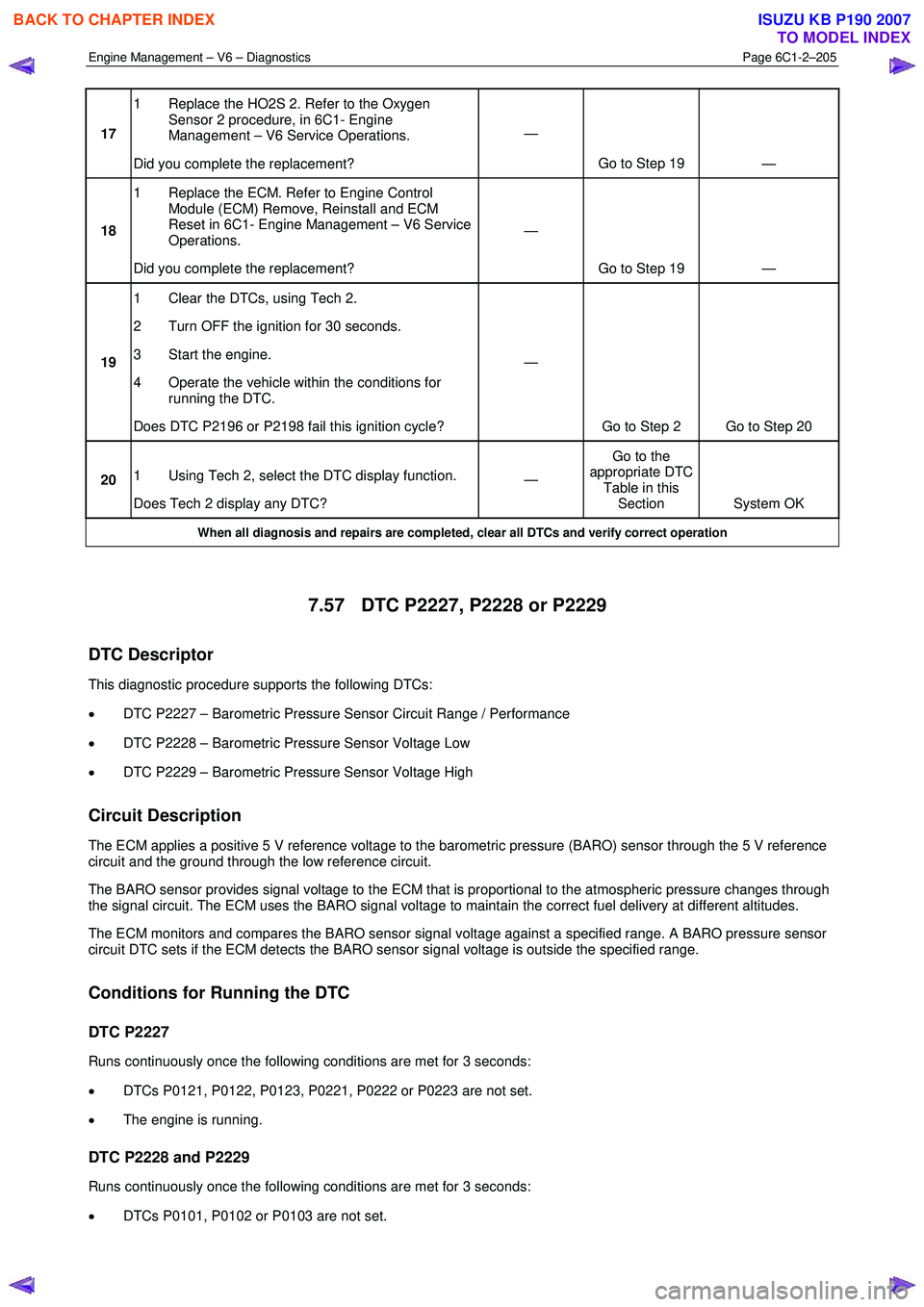
Engine Management – V6 – Diagnostics Page 6C1-2–205
17 1 Replace the HO2S 2. Refer to the Oxygen
Sensor 2 procedure, in 6C1- Engine
Management – V6 Service Operations.
Did you complete the replacement? —
Go to Step 19 —
18 1 Replace the ECM. Refer to Engine Control
Module (ECM) Remove, Reinstall and ECM
Reset in 6C1- Engine Management – V6 Service
Operations.
Did you complete the replacement? —
Go to Step 19 —
19 1 Clear the DTCs, using Tech 2.
2 Turn OFF the ignition for 30 seconds.
3 Start the engine.
4 Operate the vehicle within the conditions for running the DTC.
Does DTC P2196 or P2198 fail this ignition cycle? —
Go to Step 2 Go to Step 20
20 1 Using Tech 2, select the DTC display function.
Does Tech 2 display any DTC? —
Go to the
appropriate DTC Table in this Section System OK
When all diagnosis and repairs are completed, clear all DTCs and verify correct operation
7.57 DTC P2227, P2228 or P2229
DTC Descriptor
This diagnostic procedure supports the following DTCs:
• DTC P2227 – Barometric Pressure Sensor Circuit Range / Performance
• DTC P2228 – Barometric Pressure Sensor Voltage Low
• DTC P2229 – Barometric Pressure Sensor Voltage High
Circuit Description
The ECM applies a positive 5 V reference voltage to the barometric pressure (BARO) sensor through the 5 V reference
circuit and the ground through the low reference circuit.
The BARO sensor provides signal voltage to the ECM that is proportional to the atmospheric pressure changes through
the signal circuit. The ECM uses the BARO signal voltage to maintain the correct fuel delivery at different altitudes.
The ECM monitors and compares the BARO sensor signal voltage against a specified range. A BARO pressure sensor
circuit DTC sets if the ECM detects the BARO sensor signal voltage is outside the specified range.
Conditions for Running the DTC
DTC P2227
Runs continuously once the following conditions are met for 3 seconds:
• DTCs P0121, P0122, P0123, P0221, P0222 or P0223 are not set.
• The engine is running.
DTC P2228 and P2229
Runs continuously once the following conditions are met for 3 seconds:
• DTCs P0101, P0102 or P0103 are not set.
BACK TO CHAPTER INDEX
TO MODEL INDEX
ISUZU KB P190 2007
Page 3485 of 6020
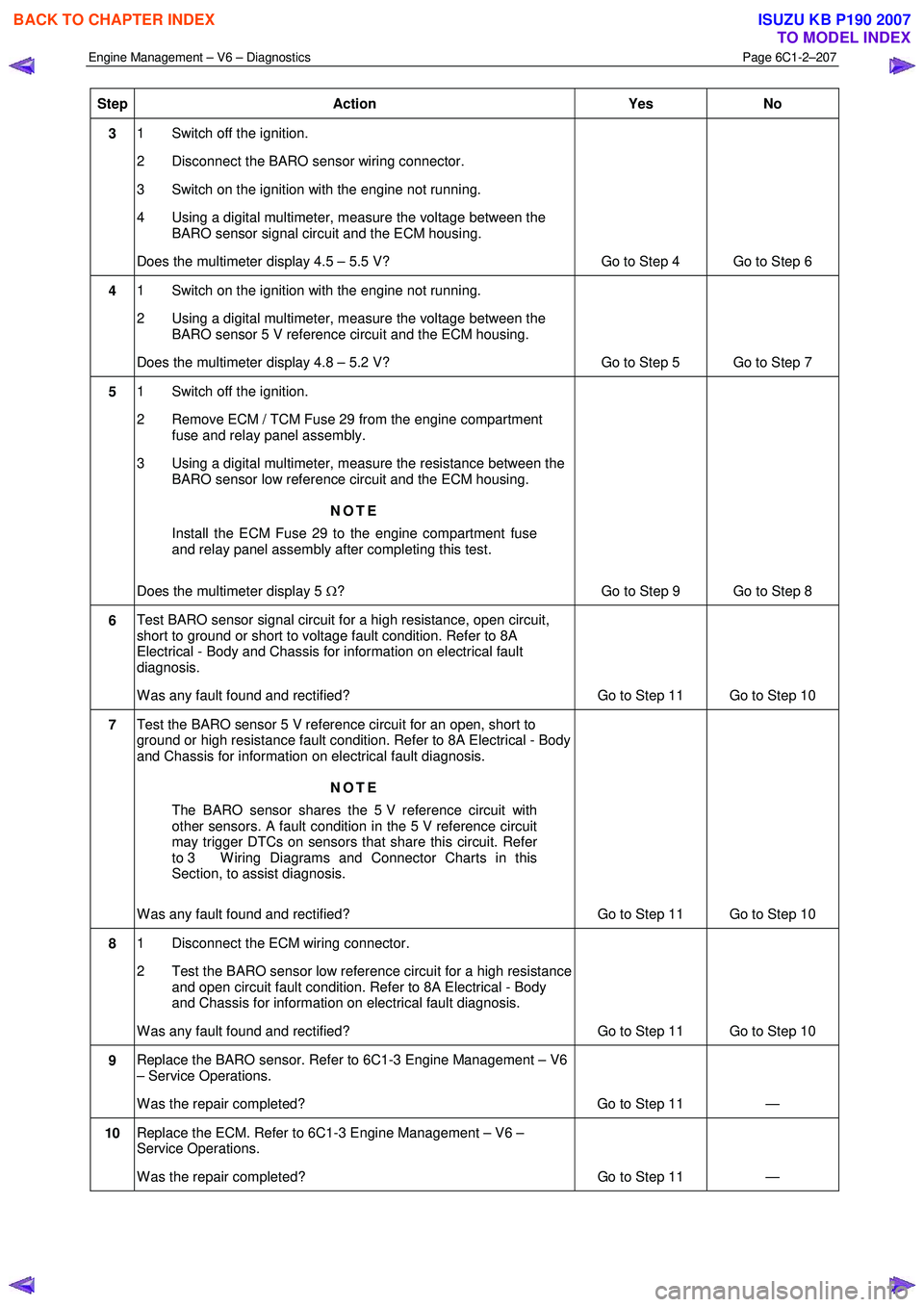
Engine Management – V6 – Diagnostics Page 6C1-2–207
Step Action Yes
No
3 1 Switch off the ignition.
2 Disconnect the BARO sensor wiring connector.
3 Switch on the ignition with the engine not running.
4 Using a digital multimeter, measure the voltage between the BARO sensor signal circuit and the ECM housing.
Does the multimeter display 4.5 – 5.5 V? Go to Step 4 Go to Step 6
4 1 Switch on the ignition with the engine not running.
2 Using a digital multimeter, measure the voltage between the BARO sensor 5 V reference circuit and the ECM housing.
Does the multimeter display 4.8 – 5.2 V? Go to Step 5 Go to Step 7
5 1 Switch off the ignition.
2 Remove ECM / TCM Fuse 29 from the engine compartment fuse and relay panel assembly.
3 Using a digital multimeter, measure the resistance between the BARO sensor low reference circuit and the ECM housing.
NOTE
Install the ECM Fuse 29 to the engine compartment fuse
and relay panel assembly after completing this test.
Does the multimeter display 5 Ω? Go to Step 9 Go to Step 8
6 Test BARO sensor signal circuit for a high resistance, open circuit,
short to ground or short to voltage fault condition. Refer to 8A
Electrical - Body and Chassis for information on electrical fault
diagnosis.
W as any fault found and rectified? Go to Step 11 Go to Step 10
7 Test the BARO sensor 5 V reference circuit for an open, short to
ground or high resistance fault condition. Refer to 8A Electrical - Body
and Chassis for information on electrical fault diagnosis.
NOTE
The BARO sensor shares the 5 V reference circuit with
other sensors. A fault condition in the 5 V reference circuit
may trigger DTCs on sensors that share this circuit. Refer
to 3 W iring Diagrams and Connector Charts in this
Section, to assist diagnosis.
W as any fault found and rectified? Go to Step 11 Go to Step 10
8 1 Disconnect the ECM wiring connector.
2 Test the BARO sensor low reference circuit for a high resistance and open circuit fault condition. Refer to 8A Electrical - Body
and Chassis for information on electrical fault diagnosis.
W as any fault found and rectified? Go to Step 11 Go to Step 10
9 Replace the BARO sensor. Refer to 6C1-3 Engine Management – V6
– Service Operations.
W as the repair completed? Go to Step 11 —
10 Replace the ECM. Refer to 6C1-3 Engine Management – V6 –
Service Operations.
W as the repair completed? Go to Step 11 —
BACK TO CHAPTER INDEX
TO MODEL INDEX
ISUZU KB P190 2007
Page 3486 of 6020
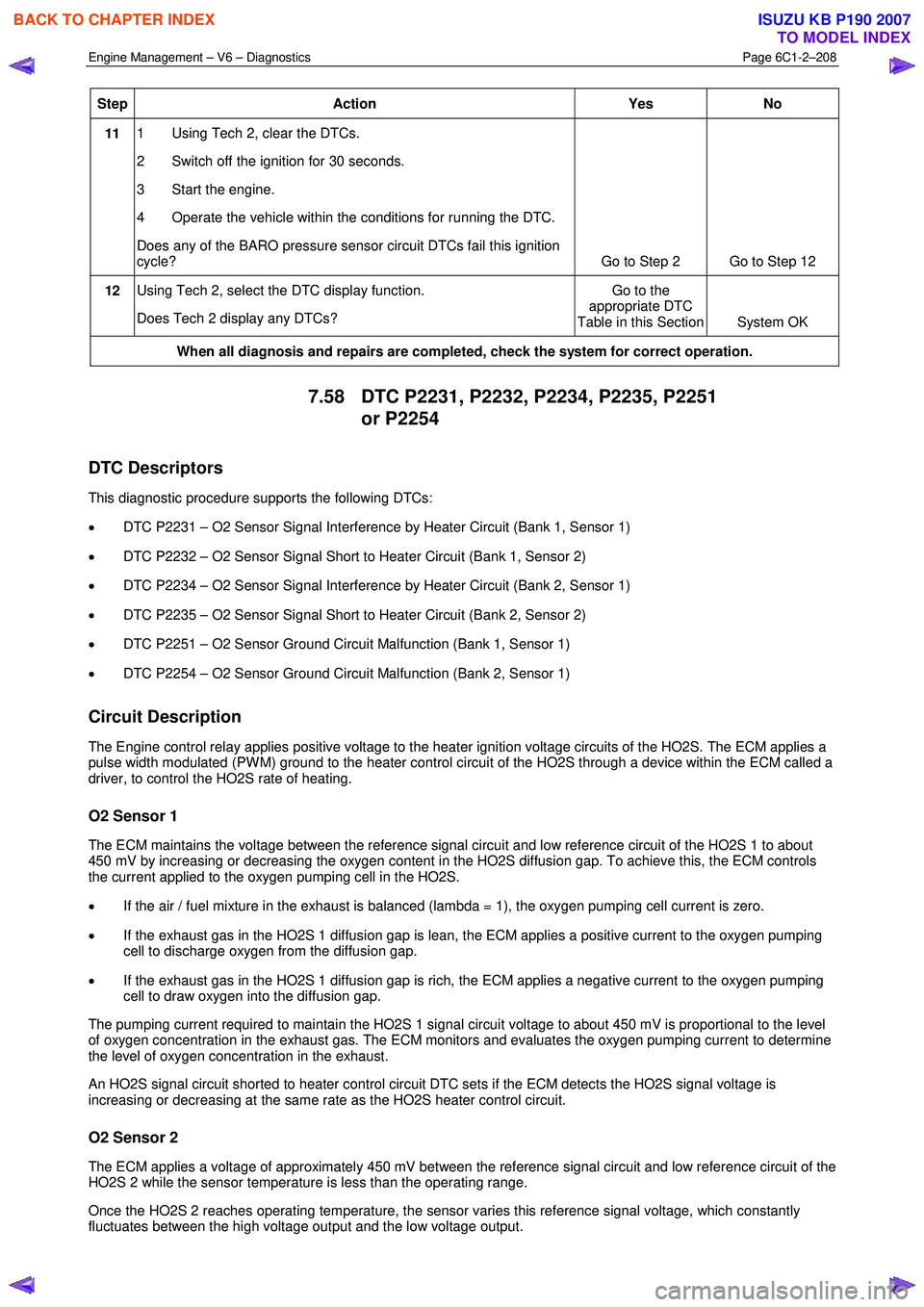
Engine Management – V6 – Diagnostics Page 6C1-2–208
Step Action Yes
No
11 1 Using Tech 2, clear the DTCs.
2 Switch off the ignition for 30 seconds.
3 Start the engine.
4 Operate the vehicle within the conditions for running the DTC.
Does any of the BARO pressure sensor circuit DTCs fail this ignition
cycle? Go to Step 2 Go to Step 12
12 Using Tech 2, select the DTC display function.
Does Tech 2 display any DTCs? Go to the
appropriate DTC
Table in this Section System OK
When all diagnosis and repairs are completed, check the system for correct operation.
7.58 DTC P2231, P2232, P2234, P2235, P2251
or P2254
DTC Descriptors
This diagnostic procedure supports the following DTCs:
• DTC P2231 – O2 Sensor Signal Interference by Heater Circuit (Bank 1, Sensor 1)
• DTC P2232 – O2 Sensor Signal Short to Heater Circuit (Bank 1, Sensor 2)
• DTC P2234 – O2 Sensor Signal Interference by Heater Circuit (Bank 2, Sensor 1)
• DTC P2235 – O2 Sensor Signal Short to Heater Circuit (Bank 2, Sensor 2)
• DTC P2251 – O2 Sensor Ground Circuit Malfunction (Bank 1, Sensor 1)
• DTC P2254 – O2 Sensor Ground Circuit Malfunction (Bank 2, Sensor 1)
Circuit Description
The Engine control relay applies positive voltage to the heater ignition voltage circuits of the HO2S. The ECM applies a
pulse width modulated (PW M) ground to the heater control circuit of the HO2S through a device within the ECM called a
driver, to control the HO2S rate of heating.
O2 Sensor 1
The ECM maintains the voltage between the reference signal circuit and low reference circuit of the HO2S 1 to about
450 mV by increasing or decreasing the oxygen content in the HO2S diffusion gap. To achieve this, the ECM controls
the current applied to the oxygen pumping cell in the HO2S.
• If the air / fuel mixture in the exhaust is balanced (lambda = 1), the oxygen pumping cell current is zero.
• If the exhaust gas in the HO2S 1 diffusion gap is lean, the ECM applies a positive current to the oxygen pumping
cell to discharge oxygen from the diffusion gap.
• If the exhaust gas in the HO2S 1 diffusion gap is rich, the ECM applies a negative current to the oxygen pumping
cell to draw oxygen into the diffusion gap.
The pumping current required to maintain the HO2S 1 signal circuit voltage to about 450 mV is proportional to the level
of oxygen concentration in the exhaust gas. The ECM monitors and evaluates the oxygen pumping current to determine
the level of oxygen concentration in the exhaust.
An HO2S signal circuit shorted to heater control circuit DTC sets if the ECM detects the HO2S signal voltage is
increasing or decreasing at the same rate as the HO2S heater control circuit.
O2 Sensor 2
The ECM applies a voltage of approximately 450 mV between the reference signal circuit and low reference circuit of the
HO2S 2 while the sensor temperature is less than the operating range.
Once the HO2S 2 reaches operating temperature, the sensor varies this reference signal voltage, which constantly
fluctuates between the high voltage output and the low voltage output.
BACK TO CHAPTER INDEX
TO MODEL INDEX
ISUZU KB P190 2007
Page 3487 of 6020
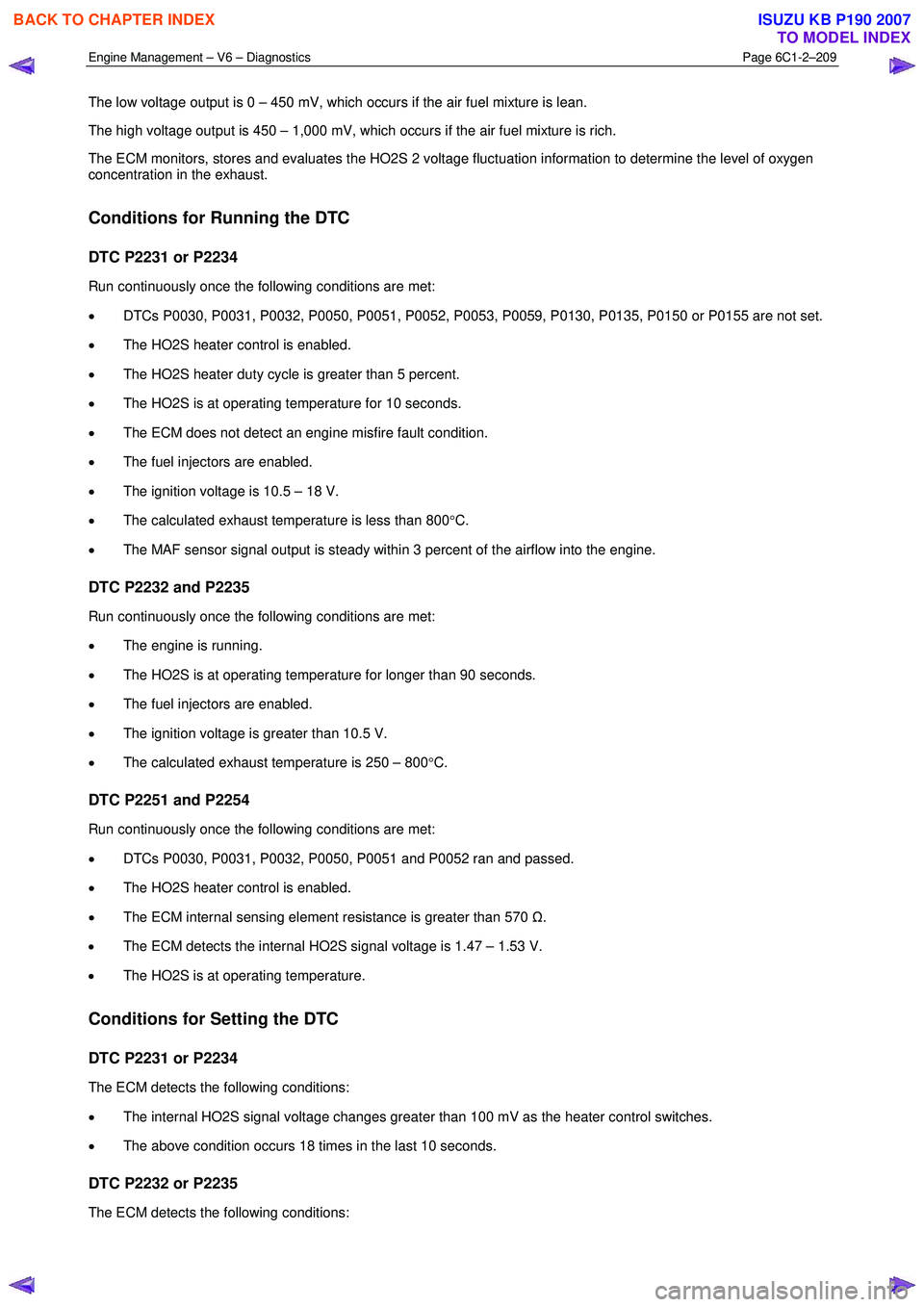
Engine Management – V6 – Diagnostics Page 6C1-2–209
The low voltage output is 0 – 450 mV, which occurs if the air fuel mixture is lean.
The high voltage output is 450 – 1,000 mV, which occurs if the air fuel mixture is rich.
The ECM monitors, stores and evaluates the HO2S 2 voltage fluctuation information to determine the level of oxygen
concentration in the exhaust.
Conditions for Running the DTC
DTC P2231 or P2234
Run continuously once the following conditions are met:
• DTCs P0030, P0031, P0032, P0050, P0051, P0052, P0053, P0059, P0130, P0135, P0150 or P0155 are not set.
• The HO2S heater control is enabled.
• The HO2S heater duty cycle is greater than 5 percent.
• The HO2S is at operating temperature for 10 seconds.
• The ECM does not detect an engine misfire fault condition.
• The fuel injectors are enabled.
• The ignition voltage is 10.5 – 18 V.
• The calculated exhaust temperature is less than 800 °C.
• The MAF sensor signal output is steady within 3 percent of the airflow into the engine.
DTC P2232 and P2235
Run continuously once the following conditions are met:
• The engine is running.
• The HO2S is at operating temperature for longer than 90 seconds.
• The fuel injectors are enabled.
• The ignition voltage is greater than 10.5 V.
• The calculated exhaust temperature is 250 – 800 °C.
DTC P2251 and P2254
Run continuously once the following conditions are met:
• DTCs P0030, P0031, P0032, P0050, P0051 and P0052 ran and passed.
• The HO2S heater control is enabled.
• The ECM internal sensing element resistance is greater than 570 Ω.
• The ECM detects the internal HO2S signal voltage is 1.47 – 1.53 V.
• The HO2S is at operating temperature.
Conditions for Setting the DTC
DTC P2231 or P2234
The ECM detects the following conditions:
• The internal HO2S signal voltage changes greater than 100 mV as the heater control switches.
• The above condition occurs 18 times in the last 10 seconds.
DTC P2232 or P2235
The ECM detects the following conditions:
BACK TO CHAPTER INDEX
TO MODEL INDEX
ISUZU KB P190 2007
Page 3489 of 6020
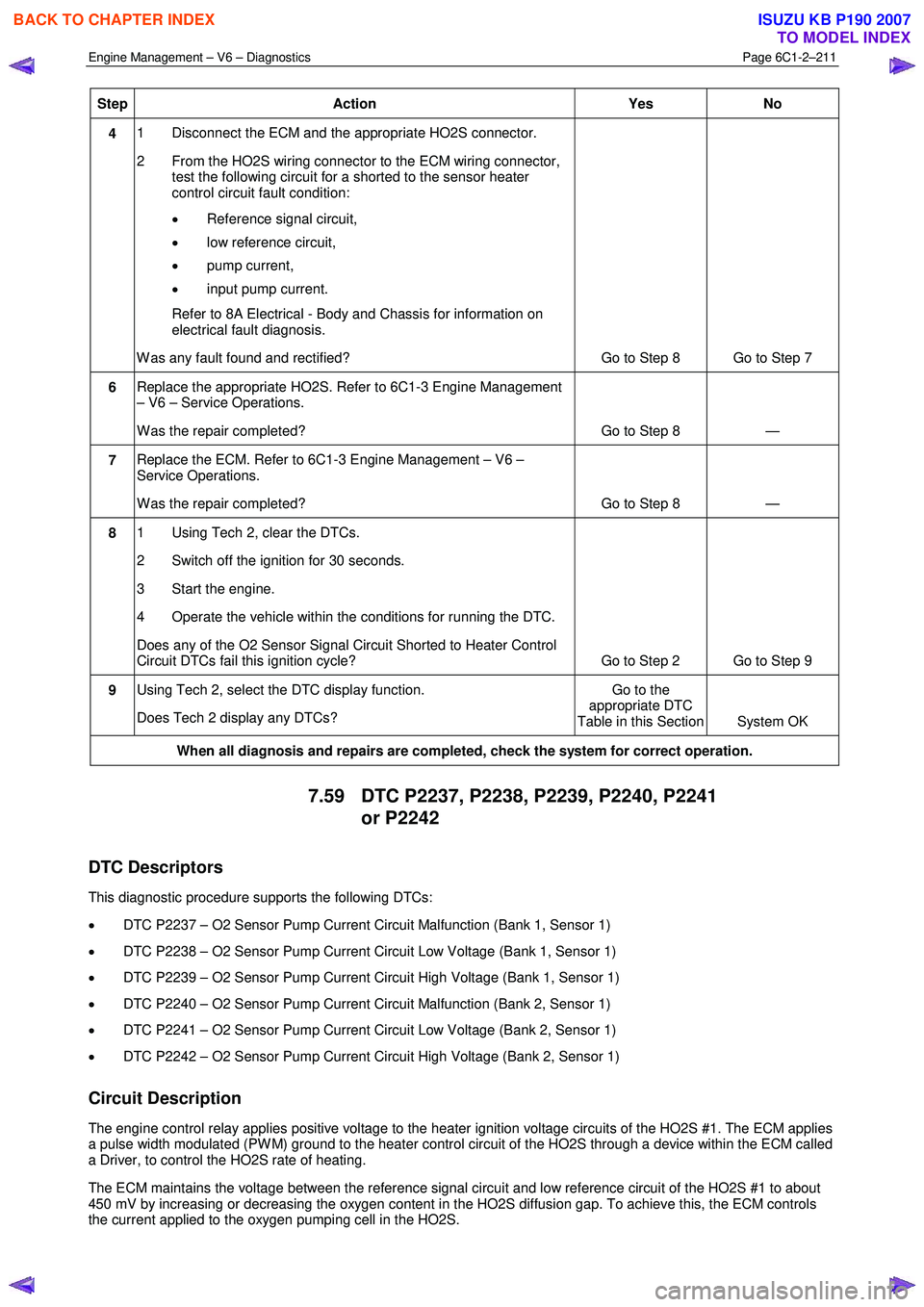
Engine Management – V6 – Diagnostics Page 6C1-2–211
Step Action Yes No
4 1 Disconnect the ECM and the appropriate HO2S connector.
2 From the HO2S wiring connector to the ECM wiring connector, test the following circuit for a shorted to the sensor heater
control circuit fault condition:
• Reference signal circuit,
• low reference circuit,
• pump current,
• input pump current.
Refer to 8A Electrical - Body and Chassis for information on electrical fault diagnosis.
W as any fault found and rectified? Go to Step 8 Go to Step 7
6 Replace the appropriate HO2S. Refer to 6C1-3 Engine Management
– V6 – Service Operations.
W as the repair completed? Go to Step 8 —
7 Replace the ECM. Refer to 6C1-3 Engine Management – V6 –
Service Operations.
W as the repair completed? Go to Step 8 —
8 1 Using Tech 2, clear the DTCs.
2 Switch off the ignition for 30 seconds.
3 Start the engine.
4 Operate the vehicle within the conditions for running the DTC.
Does any of the O2 Sensor Signal Circuit Shorted to Heater Control
Circuit DTCs fail this ignition cycle? Go to Step 2 Go to Step 9
9 Using Tech 2, select the DTC display function.
Does Tech 2 display any DTCs? Go to the
appropriate DTC
Table in this Section System OK
When all diagnosis and repairs are completed, check the system for correct operation.
7.59 DTC P2237, P2238, P2239, P2240, P2241
or P2242
DTC Descriptors
This diagnostic procedure supports the following DTCs:
• DTC P2237 – O2 Sensor Pump Current Circuit Malfunction (Bank 1, Sensor 1)
• DTC P2238 – O2 Sensor Pump Current Circuit Low Voltage (Bank 1, Sensor 1)
• DTC P2239 – O2 Sensor Pump Current Circuit High Voltage (Bank 1, Sensor 1)
• DTC P2240 – O2 Sensor Pump Current Circuit Malfunction (Bank 2, Sensor 1)
• DTC P2241 – O2 Sensor Pump Current Circuit Low Voltage (Bank 2, Sensor 1)
• DTC P2242 – O2 Sensor Pump Current Circuit High Voltage (Bank 2, Sensor 1)
Circuit Description
The engine control relay applies positive voltage to the heater ignition voltage circuits of the HO2S #1. The ECM applies
a pulse width modulated (PW M) ground to the heater control circuit of the HO2S through a device within the ECM called
a Driver, to control the HO2S rate of heating.
The ECM maintains the voltage between the reference signal circuit and low reference circuit of the HO2S #1 to about
450 mV by increasing or decreasing the oxygen content in the HO2S diffusion gap. To achieve this, the ECM controls
the current applied to the oxygen pumping cell in the HO2S.
BACK TO CHAPTER INDEX
TO MODEL INDEX
ISUZU KB P190 2007
Page 3490 of 6020

Engine Management – V6 – Diagnostics Page 6C1-2–212
• If the air / fuel mixture in the exhaust is balanced (lambda = 1), the oxygen pumping cell current is zero.
• If the exhaust gas in the HO2S #1 diffusion gap is lean, the ECM applies a positive current to the oxygen pumping
cell to discharge oxygen from the diffusion gap.
• If the exhaust gas in the HO2S #1 diffusion gap is rich, the ECM applies a negative current to the oxygen pumping
cell to draw oxygen into the diffusion gap.
The pumping current required to maintain the HO2S #1 signal circuit voltage to about 450 mV is proportional to the level
of oxygen concentration in the exhaust gas. The ECM monitors and evaluates the oxygen pumping current to determine
the level of oxygen concentration in the exhaust.
An HO2S pumping current control circuit DTC sets if the ECM detects the HO2S #1 signal voltage is outside the
predetermined range.
Conditions for Running the DTC
Condition 1
Run continuously once the following conditions are met:
• DTCs P0101, P0121, P0122, P0123, P0133, P0135, P0153, P0155, P0221, P0222, P0223, P0336 and P0338 ran
and passed.
• The ECM is commanding the lambda outside the range of 0.97 – 1.03.
• The engine is operating in closed loop.
• The HO2S heater is at operating temperature.
Condition 2
Run continuously once the following conditions are met:
• DTCs P0101, P0121, P0122, P0123, P0133, P0135, P0153, P0155, P0221, P0222, P0223, P0336 and P0338 ran
and passed.
• The ECM is commanding the lambda rich and then lean periodically with a change of greater than 2 percent.
• The ECM detects the internal HO2S signal voltage is 1.48 – 1.52 V.
• The HO2S is 0.97 – 1.03 lambda.
• The engine is operating in closed loop.
• The HO2S heater is at operating temperature.
Condition 3
Run continuously once the following conditions are met:
• DTCs P0133 and P0153 ran and passed.
• The HO2S heater is at operating temperature.
Conditions for Setting the DTC
Condition 1
The ECM detects the following conditions:
• The internal HO2S signal voltage change is 1.52 – 1.48 V.
• The above condition exists and 200 grams of exhausts gas has passed.
Condition 2
The ECM stores the fuel trim control values. This DTC sets if the ECM detects a deviation of greater than 10 percent
within 1.5 seconds between the stored value and the current value of the fuel trim.
Condition 3
The ECM detects that 5 seconds after decel fuel shut-off, the internal HO2S signal voltage is less than 1.7 V.
BACK TO CHAPTER INDEX
TO MODEL INDEX
ISUZU KB P190 2007
Page 3492 of 6020
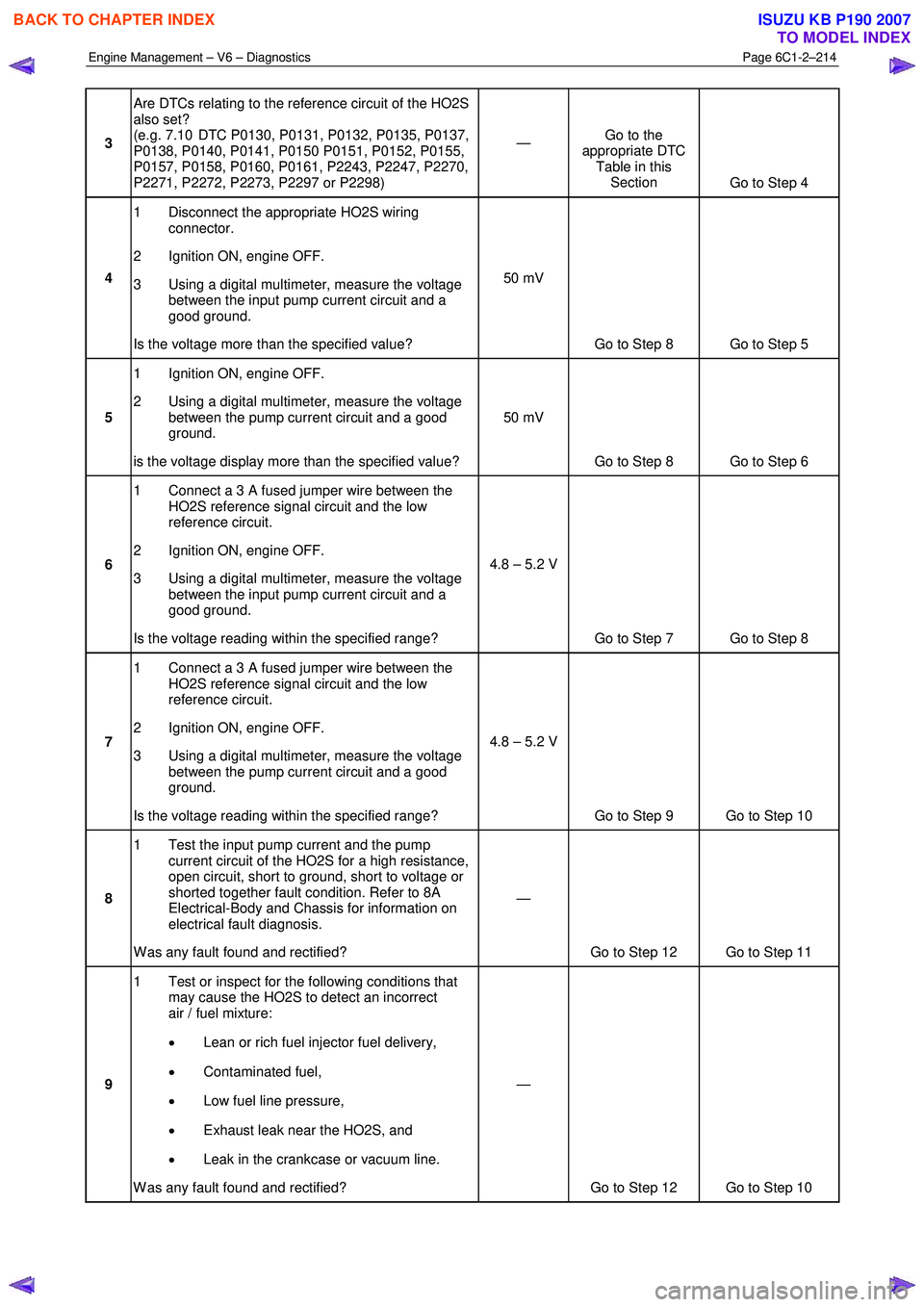
Engine Management – V6 – Diagnostics Page 6C1-2–214
3 Are DTCs relating to the reference circuit of the HO2S
also set?
(e.g. 7.10 DTC P0130, P0131, P0132, P0135, P0137,
P0138, P0140, P0141, P0150 P0151, P0152, P0155,
P0157, P0158, P0160, P0161, P2243, P2247, P2270,
P2271, P2272, P2273, P2297 or P2298) —
Go to the
appropriate DTC Table in this Section Go to Step 4
4 1 Disconnect the appropriate HO2S wiring
connector.
2 Ignition ON, engine OFF.
3 Using a digital multimeter, measure the voltage between the input pump current circuit and a
good ground.
Is the voltage more than the specified value? 50 mV
Go to Step 8 Go to Step 5
5 1 Ignition ON, engine OFF.
2 Using a digital multimeter, measure the voltage between the pump current circuit and a good
ground.
is the voltage display more than the specified value? 50 mV
Go to Step 8 Go to Step 6
6 1 Connect a 3 A fused jumper wire between the
HO2S reference signal circuit and the low
reference circuit.
2 Ignition ON, engine OFF.
3 Using a digital multimeter, measure the voltage between the input pump current circuit and a
good ground.
Is the voltage reading within the specified range? 4.8 – 5.2 V
Go to Step 7 Go to Step 8
7 1 Connect a 3 A fused jumper wire between the
HO2S reference signal circuit and the low
reference circuit.
2 Ignition ON, engine OFF.
3 Using a digital multimeter, measure the voltage between the pump current circuit and a good
ground.
Is the voltage reading within the specified range? 4.8 – 5.2 V
Go to Step 9 Go to Step 10
8 1 Test the input pump current and the pump
current circuit of the HO2S for a high resistance,
open circuit, short to ground, short to voltage or
shorted together fault condition. Refer to 8A
Electrical-Body and Chassis for information on
electrical fault diagnosis.
W as any fault found and rectified? —
Go to Step 12 Go to Step 11
9 1 Test or inspect for the following conditions that
may cause the HO2S to detect an incorrect
air / fuel mixture:
• Lean or rich fuel injector fuel delivery,
• Contaminated fuel,
• Low fuel line pressure,
• Exhaust leak near the HO2S, and
• Leak in the crankcase or vacuum line.
W as any fault found and rectified? —
Go to Step 12 Go to Step 10
BACK TO CHAPTER INDEX
TO MODEL INDEX
ISUZU KB P190 2007
Page 3493 of 6020
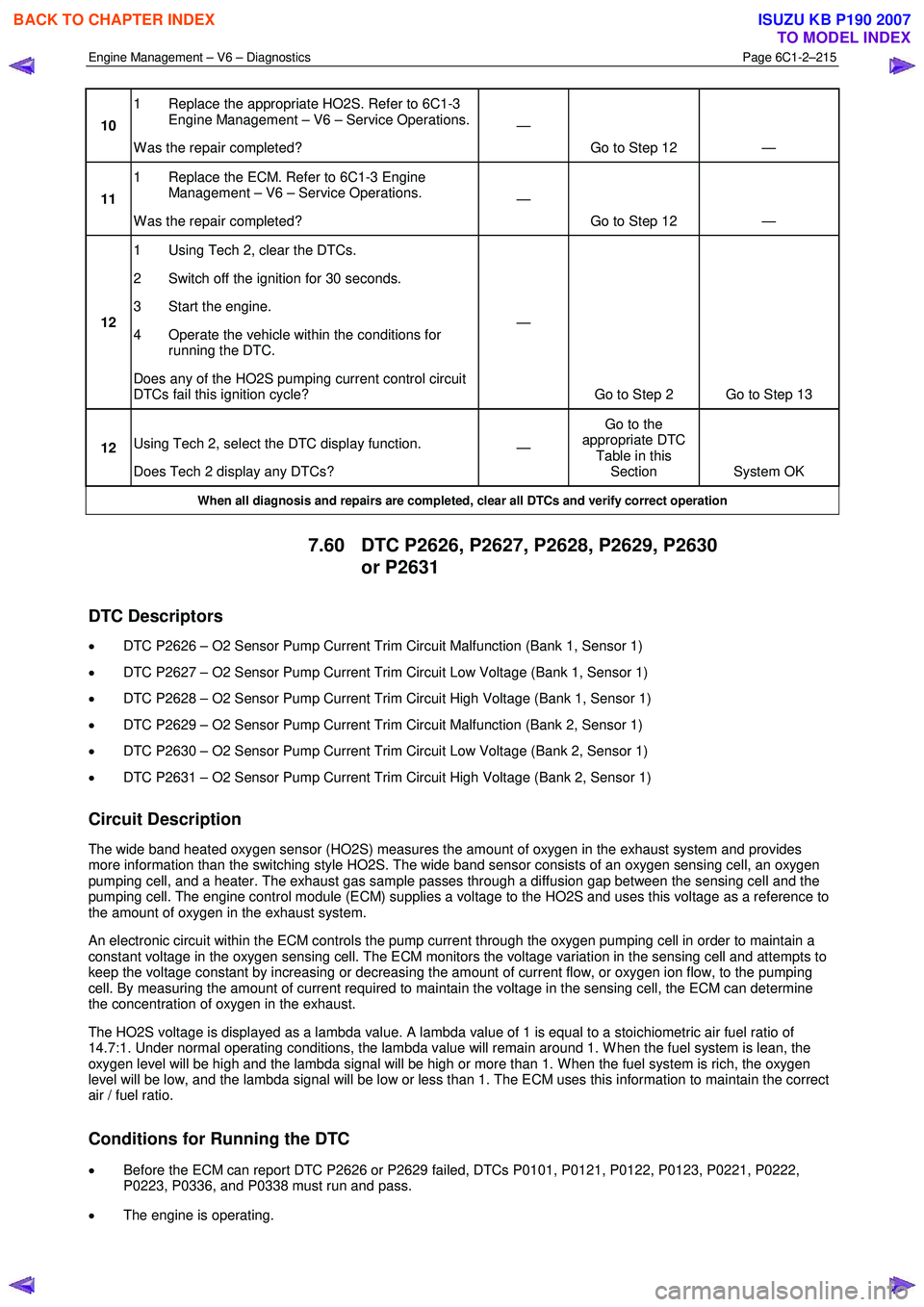
Engine Management – V6 – Diagnostics Page 6C1-2–215
10 1 Replace the appropriate HO2S. Refer to 6C1-3
Engine Management – V6 – Service Operations.
W as the repair completed? —
Go to Step 12 —
11 1 Replace the ECM. Refer to 6C1-3 Engine
Management – V6 – Service Operations.
W as the repair completed? —
Go to Step 12 —
12 1 Using Tech 2, clear the DTCs.
2 Switch off the ignition for 30 seconds.
3 Start the engine.
4 Operate the vehicle within the conditions for running the DTC.
Does any of the HO2S pumping current control circuit
DTCs fail this ignition cycle? —
Go to Step 2 Go to Step 13
12 Using Tech 2, select the DTC display function.
Does Tech 2 display any DTCs? —
Go to the
appropriate DTC Table in this Section System OK
When all diagnosis and repairs are completed, clear all DTCs and verify correct operation
7.60 DTC P2626, P2627, P2628, P2629, P2630
or P2631
DTC Descriptors
• DTC P2626 – O2 Sensor Pump Current Trim Circuit Malfunction (Bank 1, Sensor 1)
• DTC P2627 – O2 Sensor Pump Current Trim Circuit Low Voltage (Bank 1, Sensor 1)
• DTC P2628 – O2 Sensor Pump Current Trim Circuit High Voltage (Bank 1, Sensor 1)
• DTC P2629 – O2 Sensor Pump Current Trim Circuit Malfunction (Bank 2, Sensor 1)
• DTC P2630 – O2 Sensor Pump Current Trim Circuit Low Voltage (Bank 2, Sensor 1)
• DTC P2631 – O2 Sensor Pump Current Trim Circuit High Voltage (Bank 2, Sensor 1)
Circuit Description
The wide band heated oxygen sensor (HO2S) measures the amount of oxygen in the exhaust system and provides
more information than the switching style HO2S. The wide band sensor consists of an oxygen sensing cell, an oxygen
pumping cell, and a heater. The exhaust gas sample passes through a diffusion gap between the sensing cell and the
pumping cell. The engine control module (ECM) supplies a voltage to the HO2S and uses this voltage as a reference to
the amount of oxygen in the exhaust system.
An electronic circuit within the ECM controls the pump current through the oxygen pumping cell in order to maintain a
constant voltage in the oxygen sensing cell. The ECM monitors the voltage variation in the sensing cell and attempts to
keep the voltage constant by increasing or decreasing the amount of current flow, or oxygen ion flow, to the pumping
cell. By measuring the amount of current required to maintain the voltage in the sensing cell, the ECM can determine
the concentration of oxygen in the exhaust.
The HO2S voltage is displayed as a lambda value. A lambda value of 1 is equal to a stoichiometric air fuel ratio of
14.7:1. Under normal operating conditions, the lambda value will remain around 1. W hen the fuel system is lean, the
oxygen level will be high and the lambda signal will be high or more than 1. W hen the fuel system is rich, the oxygen
level will be low, and the lambda signal will be low or less than 1. The ECM uses this information to maintain the correct
air / fuel ratio.
Conditions for Running the DTC
• Before the ECM can report DTC P2626 or P2629 failed, DTCs P0101, P0121, P0122, P0123, P0221, P0222,
P0223, P0336, and P0338 must run and pass.
• The engine is operating.
BACK TO CHAPTER INDEX
TO MODEL INDEX
ISUZU KB P190 2007